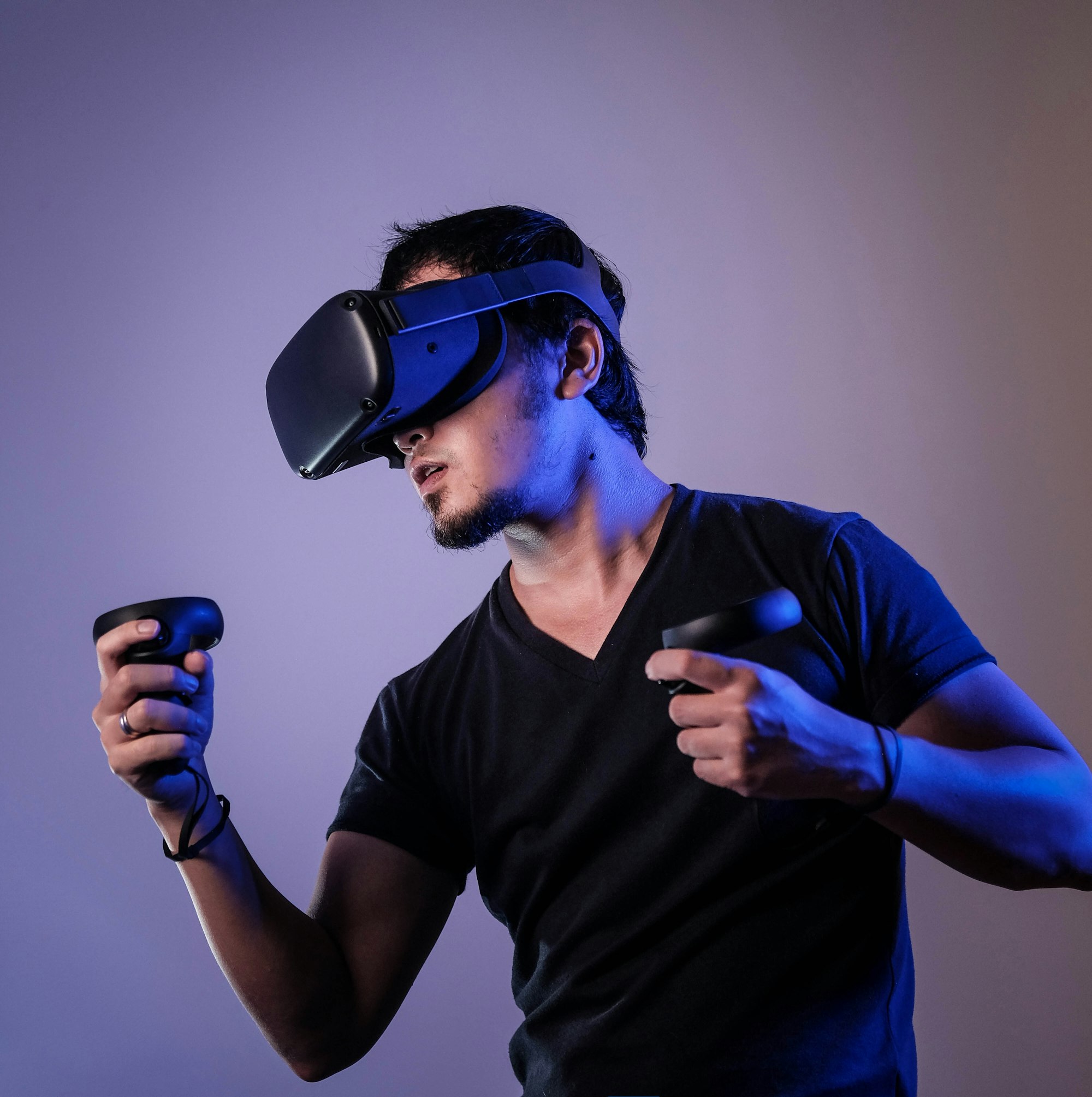Buzzwords within the technology sector, evoking images of big headsets and specialised accessories, Augmented Reality (AR) and Virtual Reality (VR) are the epitome of futuristic technology.[1] While some believe these technologies to be ultra-sophisticated, inaccessible to the general public, or reserved for hardcore gamers, some AR and VR technologies are in fact already seamlessly blended into our every-day lives. Together AR and VR are collectively referred to as Extended Reality (XR)[2].
Differences between AR and VR
Though often used in conjunction with one another or erroneously amalgamated, AR and VR are distinct forms of reality processing:
• AR superimposes digital information on the real world. Often operated through the lens of a camera, the user’s surroundings are digitally enhanced through added informational layers and virtual 3D objects.[3] You probably already came across examples of AR on your phone; whether through apps such as Pokémon Go or by using filters on your photos – yes *that* infamous “I’m not a cat” [4] Zoom filter is an example of AR.
• VR immerses users in an entirely computer-generated environment.[5] Usually, a wearable VR headset or device is used to deprive a user from interacting with the real world, while plunging them in a 3D digital experience.[6] The brain is tricked into believing this ‘cyber reality’ and, in fact, advanced VR technology projects objects anticipated by the brain to make the experience even more realistic.[7] VR is rapidly spreading and being used in numerous settings. For instance, firms, such as Lloyds Banking Group, as well as the police and army have been running VR exercises as part of their recruitment process.[8] The opportunity to simulate a working environment with different scenarios as part of the recruitment process is great way for employers to assess potential employees in a flexible and truly immersive manner.
Moreover, COVID-19 has emphasised the need for these technologies to keep firms operating smoothly. This could be seen with the increased use of virtual property inspections and “try-before-you-buy” experiences. AR and VR are also vital to help maintain social relations. They have been used in major social events, such as conferences and film festivals. In fact, according to the International Data Corporation (IDC), global spending on AR and VR will accelerate out of the pandemic, growing from just over $12 billion in 2020 to $72.8 billion in 2024.[9]
Shift from entertainment to other industries
While entertainment is traditionally viewed as the main disrupted sector by these technologies, the plethora of uses offered by these rapidly changing technologies has facilitated their incremental infiltration within most industries.[10]With the promise to revolutionise industries through accurate, cost and time effective systems, their potential impact on the modernisation of businesses is undeniable; those reluctant to integrate these cutting-edge technologies are at risk of lagging behind.
Impact on the legal sector
The legal sector is not exempt from this disruption. On one hand, AR and VR represent the perfect opportunity to modernise legal practice. The possibility of accurately re-constructing an environment digitally unlocks new opportunities in the courtroom. Firstly, this could enable judges to physically experience a disputed event through a virtual replica. Secondly, it could equip judges with a more profound understanding of events, even if they happened decades ago.[11] This avant-garde evidentiary experience was actually adopted by the Bavarian State criminal office in the Nuremburg trials.[12]
Additionally, these technologies can be used to train aspiring lawyers. Realistic interactions with simulated clients are useful for empathy training and open the door for a wider understanding of complex issues for legal trainees.[13] Virtual work experience could also be used to introduce students to the reality of working in law.
Furthermore, LawTech companies are using AR and VR technology to develop legal solutions that help increase speed, accuracy and efficiency. An example is Austria’s LeReTo, which developed an AR legal research tool that operates by scanning a document containing case references and statutes, then projecting all the refrence information onto a separate sheet of paper.[14] This quasi-instantaneous information processing has the potential to boost efficiency, save time and cost when it comes to legal research and can be useful during presentations. Instead of searching for each source individually in databases, the tool can come up with relevant files directly at the user’s hand, within seconds.
On the other hand, the legal profession will be indirectly impacted by these technologies as lawyers will have no choice but to be familiar with these technologies when advising clients on the legal and regulatory requirements deriving from their use.[15] This is especially important given that the potential impact of these technologies has been equated to that of the internet.[16] Policy makers will equally need to become acquainted with XR technologies as establishing a strong regulatory framework will be important in ensuring these technologies are properly operated.
Future Risks
The advent of 5G internet, development of smart cities, lowering hardware and software costs and the sophistication of mobile devices are all contributing to an increased popularity of XR technologies – both on the consumer and enterprise side. Another IDC study predicts the enterprise market for AR and VR would be worth roughly $56 billion by 2022, while the consumer market would be worth around $53 billion.[17]
However, this increase in scope and use also translates into security concerns. Most VR and all AR operate through device and software applications which have the potential to track geographic and personal data. This is especially important in healthcare applications that contain users’ medical records. Further to this, many applications are also dependent on the cloud to reduce memory requirements. As a result, both AR and VR present potential data security concerns, rendering users vulnerable to cyber-attacks.[18]
Key Takeaways:
• AR incorporates virtual elements into the real world while VR immerses users in an entirely computer-generated environment.
• Although they differ, they are often used together.
• The spread of VR and AR into new industries will create a shift in business.
• VR and AR could revolutionise how law firms operate and result in new regulations.
[1] Zehao He, Xiaomeng Sui, Guofan Jin, and Liangcai Cao, ‘Progress in virtual reality and augmented reality based on holographic display’ (2019) 58 (5) Applied Optics A74
[2] Heidi Fillmore and Tony Storr, AR and VR in the Workplace: Extended Reality Reimagines How Work is Done (IBM Institute for Business Value, 2020)
[3] Justin Sutherland and others, 'Applying Modern Virtual And Augmented Reality Technologies To Medical Images And Models' (2018) 32 Journal of Digital Imaging 38
[4] Jane Wakefield, ‘Viral ‘I’m not a cat’ filter is decades-old software’ (BBC News, 10 February 2021) <https://www.bbc.co.uk/news/technology-56010156> accessed 1 March 2021
[5] Rebecca Penn and Michael Hout ‘Making Reality Virtual: How VR “Tricks” Your Brain’ (Frontiers for Young Minds, 28 November 2018) <https://kids.frontiersin.org/article/10.3389/frym.2018.00062> accessed 21 February 2021
[6] ibid
[7] Lenovo, 'Don't be "tech basic:" How virtual reality tricks your brain into thinking it's real' (Mashable UK, 30 July 2018) <https://mashable.com/article/science-behind-virtual-reality/?europe=true> accessed 26 February 2021
[8] Lloyd's banking group, 'Virtual Reality Assessment Bringing assessment into the future' (Lloyd's Banking Group, 2020) <https://www.lloydsbankinggrouptalent.com/early-careers-hub/virtual-reality/> accessed 27 February 2021
[9] IDC 'Worldwide Spending On Augmented And Virtual Reality Forecast To Deliver Strong Growth Through 2024, According To A New IDC Spending Guide' (IDC, 17 November 2020) <https://www.idc.com/getdoc.jsp?containerId=prUS47012020> accessed 21 February 2021
[10] Perkins Coie LLP, 2020 Augmented and Virtual Reality Survey Report: Industry Insights into the Future of Immersive Technology (March 2020) 4
[11] Jeremy N. Bailenson, Jim Blascovich, Andrew C. Beall, and Beth Noveck, ‘Courtroom Applications of Virtual Environments, Immersive Virtual Environments, and Collaborative Virtual Environments’ (2006) 28 (2) Law & Policy 249
[12] Vaughn, 'Is Virtual Reality the Future of Courtrooms?' (Oklahoma Bar Journal, May 2019) <https://www.okbar.org/barjournal/may2019/obj9005vaughn/> accessed 25 February 2021
[13] Pettinger, 'IMPROVING LEGAL OUTCOMES WITH VIRTUAL REALITY' (Lawyer Monthly, September 2020 ) <https://www.lawyer-monthly.com/2020/09/improving-legal-outcomes-with-virtual-reality/> accessed 27 February 2021
[14] LeReTo | Legal Research Tool, ‘LeReTo goes AR | BerlinLegalTech 2019’ (YouTube, 25 February 2019)<https://www.youtube.com/watch?v=DCBFMQ4MICo&ab_channel=LeReTo%7CLegalResearchTool> accessed 1 March 2021
[15] PWC, 'Legal And Regulatory Challenges In The Enterprise Application Of Virtual And Augmented Reality: What Lies Ahead' (PWC, 2021) <https://www.pwc.co.uk/issues/intelligent-digital/virtual-reality-vr-augmented-reality-ar/legal-regulatory-challenges-enterprise-application-virtual-augmented-reality.html#1 > accessed 21 February 2021
[16] Ismail, 'The impact of AR and VR will be as big as the internet' (InformationAge, August 2019) <https://www.information-age.com/ar-vr-internet-123484383/ > accessed 26 February 2021
[17] supra n.9
[18] ibid







